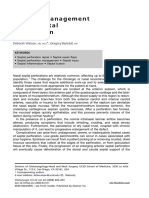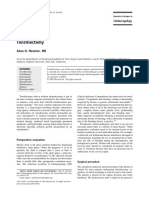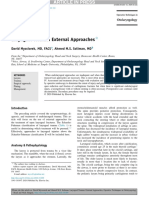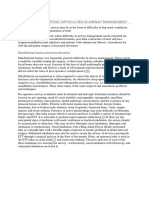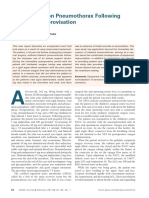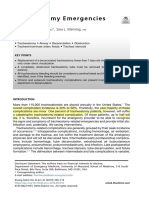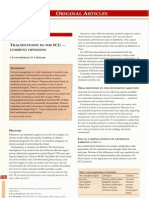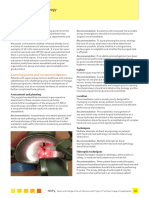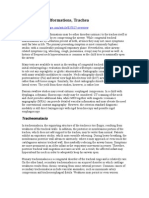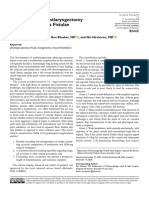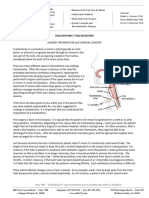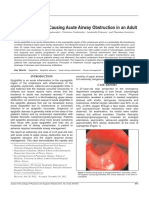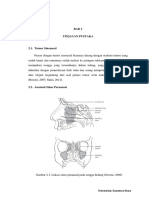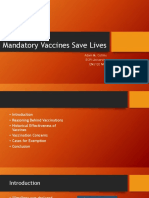Advanced Upper Airway Obstruction in ENT Surgery: Leanne Rees FRCA Rosemary A. Mason FRCA
Advanced Upper Airway Obstruction in ENT Surgery: Leanne Rees FRCA Rosemary A. Mason FRCA
Uploaded by
Ratna WindyaningrumCopyright:
Available Formats
Advanced Upper Airway Obstruction in ENT Surgery: Leanne Rees FRCA Rosemary A. Mason FRCA
Advanced Upper Airway Obstruction in ENT Surgery: Leanne Rees FRCA Rosemary A. Mason FRCA
Uploaded by
Ratna WindyaningrumOriginal Title
Copyright
Available Formats
Share this document
Did you find this document useful?
Is this content inappropriate?
Copyright:
Available Formats
Advanced Upper Airway Obstruction in ENT Surgery: Leanne Rees FRCA Rosemary A. Mason FRCA
Advanced Upper Airway Obstruction in ENT Surgery: Leanne Rees FRCA Rosemary A. Mason FRCA
Uploaded by
Ratna WindyaningrumCopyright:
Available Formats
Advanced upper airway obstruction in
ENT surgery
Leanne Rees FRCA
Rosemary A. Mason FRCA
The anaesthetic management of patients with reduction in diameter has developed gradual-
Key points
critical upper airway obstruction from tumours ly or rapidly (e.g. acute epiglottitis). Tumours
Any patient with stridor at
rest from advanced perila- involving the area around the larynx can be a normally develop slowly and the patient has
ryngeal obstruction needs challenging problem. A key message from the time to accommodate to the reduction in air-
Downloaded from https://academic.oup.com/bjaed/article-abstract/2/5/134/389129 by guest on 13 November 2018
management by experi- chapter on head and neck surgery in the 1998 way diameter and will characteristically pre-
enced senior ENT and Report of the National Confidential Enquiry into sent late in the disease. In our region, it is not
anaesthetic staff
Perioperative Deaths (NCEPOD) was that ‘the uncommon for a patient to appear for the first
It is mandatory to define
the level(s) and the extent
management of the obstructed airway gave time as an emergency in moderately severe
of the obstruction before cause for concern’. The purpose of this review is distress from stridor. Such patients are usual-
surgery; investigations to discuss the management of patients with ly heavy smokers and drinkers, are not very
should include fibre-optic advanced obstruction from tumours involving active and are often in denial about their
nasendoscopy and, in most
cases, a CT scan the proximal part of the airway. The sites of symptoms.
obstruction can be divided into supraglottic, Stridor at rest is usually obvious, although
The procedure should be
carefully planned, taking laryngeal and subglottic. Pathologies include sometimes its significance may not be recog-
into account the level and tumours of the supraglottis, pharynx, pyriform nised by clinicians from other specialities.
severity of the obstruction fossa, epiglottis, vocal cords and subglottis. The patient should be questioned about the
and the ultimate need for
tracheostomy Patients considered in this article will, by def- stridor and any positional exacerbation of
inition, have significant stridor at rest. However, symptoms. In the later stages of obstruction,
If an inhalational technique
is chosen, its safety lies in it is estimated that only 5% of laryngeal cancers nocturnal difficulties are common, usually
resisting any temptation to will present with severe dyspnoea and stridor. when the patient is supine. Ask the patient (or
take over the patient’s Therefore, these patients are encountered rarely. their partner) if he/she suddenly wakes up in
own spontaneous breath-
ing with mask ventilation Although many anaesthetists have strong views the night having acute difficulty in breathing.
about how such patients should be managed, The patient who is critically obstructed will
Whatever strategy is
planned, a fall-back posi- few will have had ‘hands-on’ experience, apart recognise this question, whereas another with
tion should be rehearsed from those regularly working in major ENT or a lesser degree of obstruction will not.
and the procedure should head and neck surgery. Since these patients may Supraglottic, pyriform fossa and pharyngeal
take place in the operating
theatre with a senior ENT present outside regular hours, experienced tumours may also produce dysphagia, some-
surgeon scrubbed, a tra- anaesthetic staff may not always be on-call. times with drooling, because the patient can-
cheostomy set opened Although only proximal airway obstruction not swallow saliva.
and a rigid broncho- will be considered in detail, reference will be
scope at hand Examination and investigations
made to the important differences in manage-
ment between proximal lesions and those Fibre-optic nasendoscopy must be performed
Leanne Rees FRCA
Specialist Registrar, Department of causing obstruction at more distal levels of by the ENT surgeon in the out-patient clinic
Anaesthesia, Swansea NHS Trust, the trachea. or on the ward. It may require no local anaes-
Morriston Hospital, Swansea SA6 6NL
thesia or simple preparation of the nose with
Rosemary A. Mason FRCA Stridor at rest lidocaine and epinephrine. The larynx is
Consultant Anaesthetist,
Department of Anaesthesia, If a patient has stridor, it implies that there is viewed from above, using a 2.7 mm, short
Swansea NHS Trust, Singleton a reduction in airway diameter of at least endoscope. The view is usually documented
Hospital, Swansea SA2 8QA
Tel: 01792 371602 50%. Beyond that, the precise percentage is with a photograph but, in the absence of a
Fax: 01792 371602
E-mail: rosemary.mason@clara.co.uk
difficult to assess clinically. The degree of dis- camera, it is important to question the surgeon
(for correspondence) tress often depends on whether or not the as to whether their diagram was an accurate
British Journal of Anaesthesia | CEPD Reviews | Volume 2 Number 5 2002 DOI 10.1093/bjacepd/02.05.134
134 © The Board of Management and Trustees of the British Journal of Anaesthesia 2002
Advanced upper airway obstruction in ENT surgery
representation of what was seen. ENT out-patient notes often Usually, it is easy to recognise the category to which a
contain an imprint of the larynx on which the surgeon can patient belongs. The patient with less severe obstruction is
draw freehand and it should not be assumed that the presence usually referred to an out-patient clinic and subsequently
of the imprint means that the larynx was actually visible. admitted for the next operating list. This is more likely to be
Nasendoscopy does not involve spraying the larynx with a someone suitable for an inhalational anaesthetic.
local anaesthetic or making contact with the vocal cords since, Another factor in the decision-making process is whether or
in a patient with significant stridor, this may be a hazardous not the patient ultimately requires a tracheostomy for thera-
manoeuvre precipitating total obstruction. If an adequate view peutic reasons, as opposed to solely for examination and treat-
of the larynx cannot be obtained, it can be reasonably expect- ment under anaesthesia. Patients with significant laryngeal or
Downloaded from https://academic.oup.com/bjaed/article-abstract/2/5/134/389129 by guest on 13 November 2018
ed that tracheal intubation will be a problem. However, suc- subglottic tumours will usually need a therapeutic tracheosto-
cessful visualisation of the larynx with the patient awake and my but, in those with supraglottic lesions, it may be possible,
in the sitting position does not mean that it will be the same in even preferable, to relieve the obstruction initially by debulk-
a supine, anaesthetised patient. ing the tumour.
Computerised tomography (CT) of the neck is especially
helpful in assessment of the subglottis and lower extent of a
Special considerations
tumour and any lesions further down the trachea. However, it Epiglottic tumours can bleed alarmingly at the slightest inter-
is less helpful in assessing the supraglottis. ference. The best attempt at tracheal intubation is the first
In the later stages of obstruction, there may be disturbances of attempt and it is advisable to start off with a long blade or a
gaseous exchange, manifested by abnormal blood gases. Serial McCoy blade. A bougie is often required to negotiate passage
pulse oximetry may be useful. Hypoxaemia, with or without around the mass. These and other types of supraglottic tumour
hypercarbia, may be entirely related to the reduction in the size pose a problem because they may partially or wholly obscure
of the airway. However, since effective coughing becomes diffi- the larynx, although the larynx itself is usually normal. In
cult at this stage, atelectasis or chest infection can be the precip- general, these patients will require laser debulking of the
itating factor for decompensation and admission to hospital. tumour followed by radiotherapy. Radiotherapists prefer to
undertake radiotherapy without a tracheostomy. Therefore,
Decision making the aim of debulking is to relieve the obstruction sufficiently
In advanced cases of perilaryngeal obstruction, the two main to avoid it. At the end of the procedure, it is often advisable to
options are tracheostomy under local anaesthesia or inhala- leave a small diameter Cook airway exchanger taped in place
tional induction of anaesthesia. so that a tracheal tube can easily be re-introduced should
In patients with stridor at rest, the first decision to be made laryngeal oedema occur.
is whether it is safe to undertake general anaesthesia before Except in an emergency, it is important to define the lower
the airway is secured. A typical patient who needs a prelimi- extent of subglottic tumours with a CT scan, since a tra-
nary local anaesthetic tracheostomy often comes to hospital cheostomy incision may enter the tumour.
for the first time as an emergency but may occasionally have
deteriorated during radiotherapy. Nocturnal respiratory diffi- Inhalational induction of anaesthesia
culties, panic attacks or hypoxaemia on admission are features An inhalational induction in a patient with stridor is difficult
suggestive of severe disease. Nasendoscopy may show a fixed and it is important to involve 2 anaesthetists and an experi-
hemilarynx, anatomical distortion and an airway that is small enced anaesthetic assistant. The most difficult part of the
or not seen. If the ENT surgeon requests general anaesthesia induction is the point at which the patient initially loses con-
because he has never done a tracheostomy under local anaes- sciousness, when respiration becomes obstructed. Insertion of
thesia, one should consider whether he/she is suitably experi- an oral airway at this stage can induce coughing and laryngeal
enced to be undertaking such surgery unsupervised. Whilst spasm. At best, this may result in a few minutes of difficulty
local anaesthetic tracheostomy is not particularly pleasant, it whilst control is regained; at worst, there can be complete loss
is preferable to a tracheostomy performed as an emergency of the airway. Insertion of an oral airway during light anaes-
when intubation under general anaesthesia has failed and the thesia is, therefore, contra-indicated. Recent radiographic and
patient is hypoxaemic. MRI studies have shown that, at induction of anaesthesia, the
British Journal of Anaesthesia | CEPD Reviews | Volume 2 Number 5 2002 135
Advanced upper airway obstruction in ENT surgery
most important cause of obstruction is not, as previously immediate tracheostomy or, if the surgeon is experienced in the
thought, posterior displacement of the tongue, but approxima- technique, a single attempt at passing a rigid bronchoscope may
be contemplated.
tion of the soft palate to the posterior pharyngeal wall. We have
found that the use of a nasal airway, rather than an oral airway,
helps to smooth out this difficult, initial phase of induction. Severe stridor requiring tracheostomy
1. Prepare the nose with a vasoconstrictor local anaesthetic, so
under local anaesthesia
that a nasal airway can be passed in the early stages, if neces- Those patients with severe stridor, a large tumour, fixed hemi-
sary. Four to five sprays of 5% cocaine are directed into each larynx, gross anatomical distortion or a larynx not visible on
nostril and the patient is asked to sniff, whilst the opposite nasendoscopy should undergo tracheostomy under local
Downloaded from https://academic.oup.com/bjaed/article-abstract/2/5/134/389129 by guest on 13 November 2018
side is occluded.
anaesthesia. No sedation should be given. The use of a heli-
2. Induce anaesthesia in theatre with full monitoring, i.v. fluids um/oxygen mixture undoubtedly improves symptoms. Heliox
and the surgeon standing by scrubbed ready in case emer- cylinders contain only 21% oxygen. Therefore, to achieve
gency tracheostomy is required. A rigid, ventilating broncho-
higher concentrations, a medical helium cylinder can be
scope should also be at hand.
adapted to fit into the air rotameter on the anaesthetic machine
3. Start induction of anaesthesia with sevoflurane and 100% oxy- and the flow meters adjusted to deliver the required percent-
gen, and continue until the blood pressure starts to decrease.
age of oxygen. However, once oxygen is given, tracheostomy
4. If the patient becomes apnoeic, as often occurs during should not be delayed because, in a chronically obstructed
sevoflurane induction, do not be tempted to assist ventilation. patient, relief of hypoxaemia may precipitate CO2 retention
Allow the CO2 to rise and the patient will start to breathe and loss of consciousness. Patients who are close to becoming
again.The safety of an inhalational technique lies in the main-
completely obstructed may find it difficult to tolerate the
tenance of spontaneous respiration.
supine position, so initial preparations for surgery may have to
5. If the airway obstructs, do not insert an oral airway because be made with the patient sitting. Once the tracheostomy tube
the patient may start to cough and develop laryngeal spasm.
is in place and its position confirmed with the capnograph,
Instead, gently insert a lubricated 6 or 7 mm nasopharyngeal
airway.This will usually improve respirations. anaesthesia is induced so that a full examination can be made
and biopsies taken.
6. Induction takes time and cannot be hurried. Sevoflurane is an
ideal agent with which to begin induction. However, in some
patients it may fail to provide anaesthesia of adequate depth
Anaesthesia after securing the airway
and for a sufficient length of time, to perform direct laryn- Once the airway has been secured, the surgeon will examine
goscopy and pass a tube. In such patients, a change to the tumour under anaesthesia, take biopsies or perform a
halothane may be required. Simple clinical observations will debulking procedure. Choice of anaesthetic technique is not
suggest if and when this is necessary. If, during induction, the
critical for this stage but we prefer to use a total intravenous
blood pressure fails to decrease on sevoflurane and the pupils
do not become small and central, it is likely that anaesthesia is
infusion technique using remifentanil and propofol as this
not deep enough for instrumentation. In this event, a change provides better control of extubation.
to halothane is worthwhile.
Tracheostomy management
7. When anaesthesia is finally considered to be deep enough, gen-
If a surgical tracheostomy has been formed, the patient will
tle laryngoscopy should be attempted, using a long or McCoy
blade.A rapid decision must now be made as to whether or not need analgesia before reversal of anaesthesia. We prefer intra-
to pass a suitably sized tube. If, under direct vision, the anatomy muscular morphine and cyclizine given 30 min before the end
is difficult to visualise, or the aperture is judged to be too small, of surgery. Morphine also acts as a cough suppressant and
it may be prudent to withdraw and allow the surgeon to under- helps the patient tolerate the presence of the tracheostomy
take an unhurried tracheostomy while the patient still maintains
tube in the initial stages. Humidification will be required until
adequate spontaneous respiration. If a decision is made to try to
the tracheal mucosa has adapted to the outside air.
pass a tube, only one or two attempts must be made. Ill-judged
or persistent attempts at tracheal intubation may result in total
Tracheal tube management
obstruction, or bleeding from the tumour. It is unwise to give a
muscle relaxant until the tube is down, particularly when the If tracheostomy has been avoided, the tube must not be
tumour is subglottic. Sudden complete obstruction requires removed until the patient is awake. One advantage of remifen-
136 British Journal of Anaesthesia | CEPD Reviews | Volume 2 Number 5 2002
Advanced upper airway obstruction in ENT surgery
tanil is that the return of consciousness and the cough reflex 3. Perfect local anaesthesia – in the presence of a tumour, good
occur almost simultaneously. This avoids the period of intense local anaesthesia is difficult to achieve by any method. In addi-
tion, laryngeal spasm may precipitate total airway obstruction
coughing and associated cardiovascular stimulation which
in the patient who is awake.
occur with most other techniques when the tube is still in
place. Since laryngeal oedema can develop initially when the 4. Ability to distinguish the anatomy – if the anatomy is difficult
tube is no longer splinting the larynx, in some patients, the to distinguish with a standard laryngoscope, what hope is
there with the view provided by a 4 mm fibrescope? The abili-
tube can be removed over a small Cook airway exchanger.
ty to see through a fibrescope depends on the presence of an
This is often well tolerated and can be left in place until it is air space. In addition, the view is much worse than that seen
certain that the patient can breathe adequately. The Cook air- using a Macintosh laryngoscope.
Downloaded from https://academic.oup.com/bjaed/article-abstract/2/5/134/389129 by guest on 13 November 2018
way exchanger has the advantage of allowing either insuffla-
5. Minimal blood and secretions – there is a risk of dislodging
tion of oxygen via a normal connector or Venturi ventilation tumour or of causing haemorrhage, particularly with supra-
with a Manujet (VBM Medizintechnik GmbH, Neckar, glottic tumours.
Germany) using the Luer lock connector.
6. The ‘cork-in-bottle’ situation – if you try to pass a 4 mm
If debulking has been undertaken, humidification and dex- bronchoscope into a 5 mm hole, it completely obstructs the
amethasone may be required for 24 h. In patients in whom a patient’s airway. If you do succeed in passing the fibrescope
severe degree of obstruction has been present for some time, into the larynx, you will have ‘corked off’ the patient’s remain-
pulmonary oedema may follow tracheostomy. This may be ing airway and he will fight vigorously to prevent you thread-
exacerbated by the fact that the patient can no longer generate ing a tube into the trachea.These patients are often mildly
hypoxaemic to start with. If adequate pre-oxygenation has not
an expired positive pressure. In cases of mild hypoxaemia, a
taken place, oxygen saturations rapidly decrease, so uncon-
CPAP device connected to the tracheostomy may be sufficient sciousness and apnoea will supervene rapidly. If you fail to
to improve oxygenation; in more severe cases, IPPV may be pass a tube at this stage, the only fall-back strategy will be
required for 24 h. emergency tracheostomy, in the anaesthetic room, in a patient
unconscious from hypoxaemia.
Why is fibre-optic intubation not a safe
technique for a patient with advanced Cautions concerning other techniques
obstruction from a periglottic tumour? Some rely upon cricothyrotomy and Venturi ventilation as a
Why do many anaesthetists believe that awake fibre-optic fall-back strategy. Whilst this can be life-saving under many
intubation is the method of choice in obstructing laryngeal circumstances, in the case of advanced tumours barotrauma is
tumours? The answer most often given is that ‘the awake a risk because the obstruction does not allow sufficient room
patient maintains his/her own airway’. Whilst this is true for for expiration. If cricothyrotomy has to be performed, it is
the patient in whom conventional tracheal intubation is important to begin with very low pressures. A commercial
impossible for anatomical reasons, it does not necessarily Venturi device that allows control of the inspired pressure,
apply to the patient who has severe pathological obstruction such as the Manujet, must be available in theatre.
from a lesion in the periglottic area. In fact, the patient whose Percutaneous tracheostomy is unsuitable for first-line man-
breathing is increasingly being compromised by tumour final- agement of obstructive lesions, because of the inability to
ly presents to hospital for the very reason that he cannot monitor the insertion procedure with a fibrescope. In addition,
maintain his own airway. If we examine the conditions with subglottic lesions, there is a danger of inserting the
required to produce a smooth awake fibre-optic intubation and guidewire directly into tumour. However, it may be a useful
apply them to a patient with severe obstruction, then it alternative to surgical tracheostomy, as a temporary measure
becomes apparent why it is a less than ideal technique in these once the airway has been secured and anaesthesia induced.
circumstances.
1. Judicious, light sedation – it is dangerous to sedate a patient Importance of locating obstruction in the
with stridor. lower trachea
2. A calm patient – a patient with critical airway obstruction is Obstruction of the mid and lower trachea poses an entirely dif-
terrified. ferent management problem from that of laryngeal obstruction.
British Journal of Anaesthesia | CEPD Reviews | Volume 2 Number 5 2002 137
Advanced upper airway obstruction in ENT surgery
When mid-tracheal obstruction results from a thyroid mass com- because it may precipitate complete airway obstruction.
pressing the trachea, tracheostomy cannot be performed because Again, a CT scan is essential. If the obstruction is close to the
the thyroid is in the way. Thus, an inhalational induction would carina, or invading a bronchus, the patient should be trans-
be unsuitable as a first choice of induction because, if obstruc- ferred to a unit with cardiothoracic facilities, in case car-
tion suddenly occurs, emergency tracheostomy is not an option. diopulmonary bypass is needed. In the event of an emergency
Fortunately nowadays, with the advent of CT scans, the site and in which a scan cannot be performed, insertion of a rigid bron-
exact dimensions of the narrowest portion of the trachea can be choscope may be life-saving.
measured. Provided there is sufficient clearance above the cari-
na for the tracheal cuff, in most cases a standard intravenous
Key references
Downloaded from https://academic.oup.com/bjaed/article-abstract/2/5/134/389129 by guest on 13 November 2018
Bradley PJ. Treatment of the patient with upper airway obstruction
induction can be performed. With benign thyroid lesions, the
caused by cancer of the larynx. Otolaryngol Head Neck Surg 1999; 120:
compression is soft, so it is possible to pass a larger tube than the 737–41
CT measurements show. In contrast, thyroid carcinomas are Goh MH, Liu XY, Goh YS. Anterior mediastinal masses: an anaesthetic
unyielding and tumour can invade the tracheal wall. Thus, there challenge. Anaesthesia 1999; 54: 670–4
is always the possibility of tracheal collapse following muscle Gray AJG, Hoile RW, Ingram GS, Sherry K. Report of the National
Confidential Enquiries into Perioperative Deaths 1996/7. London: NCE-
relaxant administration. In all cases, a rigid bronchoscope should POD, 1998
be at hand. Mason RA, Fielder CP.The obstructed airway in head and neck surgery.
In the case of a lymphoma or carcinoma compressing the Anaesthesia 1999; 54: 625–8
lower trachea (and possibly a bronchus), again a tracheostomy Shaw IC,Welchew EA, Harrison BJ, Michael S. Complete airway obstruc-
will not solve the problem, since the tracheostomy tube will tion during awake fibreoptic intubation. Anaesthesia 1997; 52: 582–5
not be long enough to relieve the obstruction. General anaes-
thesia in which a muscle relaxant is given is contra-indicated See multiple choice questions 89–93.
138 British Journal of Anaesthesia | CEPD Reviews | Volume 2 Number 5 2002
You might also like
- Swarthz TRAUMADocument26 pagesSwarthz TRAUMAAlexandra Niken Larasati75% (4)
- Corona Virus Rescue Handbook Kerri Rivera AutismONEDocument36 pagesCorona Virus Rescue Handbook Kerri Rivera AutismONESetagNo ratings yet
- First Aid MB Lesson OutlineDocument4 pagesFirst Aid MB Lesson Outlineapi-455219103No ratings yet
- Supporting Community-Based Disaster ResponseDocument10 pagesSupporting Community-Based Disaster ResponseBill de BlasioNo ratings yet
- The Illustrated Guide To Hot and Cold Water ServicesDocument65 pagesThe Illustrated Guide To Hot and Cold Water ServicesRodolfo Espinosa100% (3)
- WFSA Tutorial 336Document9 pagesWFSA Tutorial 336Pratiwi WibisonoNo ratings yet
- 267 English 1Document8 pages267 English 1Abante_gammaNo ratings yet
- 06 Preanaesthetic - Airway - Endoscopy - Real - and - VirtualDocument5 pages06 Preanaesthetic - Airway - Endoscopy - Real - and - VirtualanestesiapopurriNo ratings yet
- Interventional Radiology Treatment of Empyema and Lung AbscessesDocument8 pagesInterventional Radiology Treatment of Empyema and Lung AbscessesEduardo Alejandro IIINo ratings yet
- PIIS152229420800007XDocument13 pagesPIIS152229420800007XOskar MartinezNo ratings yet
- Endoscopic Ligation of The SphenopalatineDocument5 pagesEndoscopic Ligation of The Sphenopalatinett10121998No ratings yet
- 241 TracheostomyDocument12 pages241 Tracheostomyalbert hutagalungNo ratings yet
- Surgic Al Ma Na Gement Oftheseptal Per Forat Ion: Deborah Watson,, Gregory BarkdullDocument11 pagesSurgic Al Ma Na Gement Oftheseptal Per Forat Ion: Deborah Watson,, Gregory BarkdullVinoth LakshmikanthNo ratings yet
- Begin Stenosis of The Trachea. TCNA 2014Document7 pagesBegin Stenosis of The Trachea. TCNA 2014Javier VegaNo ratings yet
- Neck Surgery Anesthesia For Otolaryngology-Head &: Key ConceptsDocument25 pagesNeck Surgery Anesthesia For Otolaryngology-Head &: Key ConceptsCarolina SidabutarNo ratings yet
- Krespi 1997Document4 pagesKrespi 1997kwpang1No ratings yet
- TonsillectomyDocument5 pagesTonsillectomyThomasMáximoMancinelliRinaldoNo ratings yet
- Aijoc 2013 05 043Document3 pagesAijoc 2013 05 043Hussein AhmedNo ratings yet
- Jurnal Laryngeal TraumaDocument7 pagesJurnal Laryngeal TraumaadindaNo ratings yet
- Conditions That Pose Difficulties in Airway ManagementDocument4 pagesConditions That Pose Difficulties in Airway ManagementAnonymous 4b6BT9afNo ratings yet
- Bilateral Tension Pneumothorax Following Equipment ImprovisationDocument6 pagesBilateral Tension Pneumothorax Following Equipment ImprovisationIlvita MayasariNo ratings yet
- TRAUMA Pulmones, Traquea y EsofagoDocument14 pagesTRAUMA Pulmones, Traquea y EsofagosantigarayNo ratings yet
- Sub GlotticDocument27 pagesSub Glotticahmed helalNo ratings yet
- Anesthesia For Ambulatory Diagnostic and Therapeutic Radiology ProceduresDocument19 pagesAnesthesia For Ambulatory Diagnostic and Therapeutic Radiology ProceduresReza RahardianNo ratings yet
- Intervencion Usg EmergenciasDocument22 pagesIntervencion Usg EmergenciasSaul Gonzalez HernandezNo ratings yet
- Anaesthesia and Common Oral and Maxillo-Facial EmergenciesDocument6 pagesAnaesthesia and Common Oral and Maxillo-Facial EmergenciesJoao Dos SantosNo ratings yet
- Radiology in Paediatric Non-Traumatic Thoracic Emergencies: Insights Into Imaging October 2011Document15 pagesRadiology in Paediatric Non-Traumatic Thoracic Emergencies: Insights Into Imaging October 2011amaliaNo ratings yet
- Airway Management in Head and Neck Cancer SurgeryDocument5 pagesAirway Management in Head and Neck Cancer SurgeryGisel Rojas RuizNo ratings yet
- Tracheostomy EmergenciesLaura J. BontempoDocument11 pagesTracheostomy EmergenciesLaura J. BontempoIsmael Erazo AstudilloNo ratings yet
- 25 Maxillofacial and Dental SurgeryDocument9 pages25 Maxillofacial and Dental SurgeryanestesiapopurriNo ratings yet
- Airway and Ventilatory ManagementDocument8 pagesAirway and Ventilatory ManagementAshen DissanayakaNo ratings yet
- Nasolaryngoscopy: Scott E. MoserDocument5 pagesNasolaryngoscopy: Scott E. Moserriski novitaNo ratings yet
- 6 Original Articles - Review Article - Tracheotomy in The Icu - Current Opinions, C R Van Schalkwyk WDocument4 pages6 Original Articles - Review Article - Tracheotomy in The Icu - Current Opinions, C R Van Schalkwyk WAbhilash AntonyNo ratings yet
- Anaesthesia For Tracheal and Airway Surgery: Aetiology of Adult Laryngotracheal StenosisDocument4 pagesAnaesthesia For Tracheal and Airway Surgery: Aetiology of Adult Laryngotracheal StenosisRicardoNo ratings yet
- Post Op Difficult AirwayDocument7 pagesPost Op Difficult AirwaylucasNo ratings yet
- Uia28 TracheostomyDocument8 pagesUia28 TracheostomyAashik 249No ratings yet
- Tracheal TraumaDocument3 pagesTracheal TraumaWalid DarwicheNo ratings yet
- Nasal Septal PerforationDocument12 pagesNasal Septal PerforationRini RahmawulandariNo ratings yet
- Anaesthetic Management: VitrectomyDocument3 pagesAnaesthetic Management: Vitrectomydrardigustian2986No ratings yet
- Anesthesia Considerations in Microlaryngoscopy or Direct LaryngosDocument6 pagesAnesthesia Considerations in Microlaryngoscopy or Direct LaryngosRubén Darío HerediaNo ratings yet
- Summary Learning Points On Head and Neck From NAP4 Report 2011Document2 pagesSummary Learning Points On Head and Neck From NAP4 Report 2011hlouis8No ratings yet
- Case Onko 2 Febby ShabrinaDocument16 pagesCase Onko 2 Febby ShabrinaVandy IkraNo ratings yet
- Examination of The Pharynx and The LarynxDocument4 pagesExamination of The Pharynx and The LarynxIsraël KimvonoNo ratings yet
- Tracheal StenosisDocument5 pagesTracheal StenosisGiovanni HenryNo ratings yet
- Congenital Malformations, TrakeaDocument3 pagesCongenital Malformations, TrakeaAntonia DinaNo ratings yet
- Klasifikasi PCFDocument2 pagesKlasifikasi PCFmikhaelyosiaNo ratings yet
- Congenital Upper Airway Obstruction: Robert DinwiddieDocument8 pagesCongenital Upper Airway Obstruction: Robert DinwiddieadeNo ratings yet
- MKW 077Document7 pagesMKW 077Sans AndreasNo ratings yet
- Non Surgical TEDocument8 pagesNon Surgical TEhqdmnrxb6rNo ratings yet
- Lesson PlanDocument5 pagesLesson PlanAdham YounesNo ratings yet
- 21 ExtubationDocument8 pages21 ExtubationanestesiapopurriNo ratings yet
- MKX 028Document7 pagesMKX 028Gilang GaluhNo ratings yet
- Percutaneous Dilatational Tracheostomy: July 2014Document10 pagesPercutaneous Dilatational Tracheostomy: July 2014Dita NitaNo ratings yet
- 2022 Nasal Pyriform Aperture StenosisDocument2 pages2022 Nasal Pyriform Aperture StenosisNicolien van der PoelNo ratings yet
- عبادة و يوسفDocument50 pagesعبادة و يوسفHard TubeNo ratings yet
- TracheostomyDocument4 pagesTracheostomymindreader19No ratings yet
- Postoperative Care of Oral and Maxillofa PDFDocument10 pagesPostoperative Care of Oral and Maxillofa PDFMashood AhmedNo ratings yet
- TRACHEOTOMY ReformattedDocument3 pagesTRACHEOTOMY ReformattedBrajesh MeenaNo ratings yet
- FRCA SAQ1Practice - Ans19113Document47 pagesFRCA SAQ1Practice - Ans19113drhms200090% (10)
- Airway and Ventilatory Management (ATLS2)Document12 pagesAirway and Ventilatory Management (ATLS2)mohammedsalehsroor673No ratings yet
- State of the Art Techniques in Critical Care Echocardiography: 3D, Tissue, ContrastFrom EverandState of the Art Techniques in Critical Care Echocardiography: 3D, Tissue, ContrastKonstantin YastrebovNo ratings yet
- JR FPR - Pectoralis Major Myocutaneous Flap - EdwinaDocument41 pagesJR FPR - Pectoralis Major Myocutaneous Flap - EdwinaRatna WindyaningrumNo ratings yet
- Isolation Grown Fluid Resistant GrownDocument3 pagesIsolation Grown Fluid Resistant GrownRatna WindyaningrumNo ratings yet
- Journal Reading: Presented By: Ratna WindyaningrumDocument46 pagesJournal Reading: Presented By: Ratna WindyaningrumRatna WindyaningrumNo ratings yet
- Lanvers Kaminsky2017Document14 pagesLanvers Kaminsky2017Ratna WindyaningrumNo ratings yet
- Brainerd HumComm 1978Document9 pagesBrainerd HumComm 1978Ratna WindyaningrumNo ratings yet
- Bab 2Document3 pagesBab 2Ratna WindyaningrumNo ratings yet
- LR Middle Ear Inflammation AODocument42 pagesLR Middle Ear Inflammation AORatna WindyaningrumNo ratings yet
- Klasifikasi Tumor SinonasalDocument22 pagesKlasifikasi Tumor SinonasalelFadhlyNo ratings yet
- Journal Reading DR - AdDocument29 pagesJournal Reading DR - AdRatna WindyaningrumNo ratings yet
- A Nationwide Survey of Inhalant Allergens Sensitization and Levels of Indoor Major Allergens in KoreaDocument6 pagesA Nationwide Survey of Inhalant Allergens Sensitization and Levels of Indoor Major Allergens in KoreaRatna WindyaningrumNo ratings yet
- Vestibular Function and Anatomy RatnaDocument36 pagesVestibular Function and Anatomy RatnaRatna WindyaningrumNo ratings yet
- Basic Immunology: Ratna Windyaningrum Supervisor: Dr. Arif Dermawan, M.Kes., Sp. T.H.T.K.L (K)Document42 pagesBasic Immunology: Ratna Windyaningrum Supervisor: Dr. Arif Dermawan, M.Kes., Sp. T.H.T.K.L (K)Ratna Windyaningrum100% (1)
- Environmental and Occupational AllergiesDocument11 pagesEnvironmental and Occupational AllergiesRatna WindyaningrumNo ratings yet
- MasterDataObat 27072020Document300 pagesMasterDataObat 27072020Bogi Aditya PermanaNo ratings yet
- Annual Report 2018 2019 CompressedDocument40 pagesAnnual Report 2018 2019 CompressedGlennadi R. RualoNo ratings yet
- Physical 11 PaperDocument2 pagesPhysical 11 PaperExpress CoderNo ratings yet
- Mandatory Vaccines Save Lives: Adam M. Collins ECPI University Eng120 NFHDocument24 pagesMandatory Vaccines Save Lives: Adam M. Collins ECPI University Eng120 NFHAdam CollinsNo ratings yet
- Drug Discovery and Development: Understanding The R&D ProcessDocument14 pagesDrug Discovery and Development: Understanding The R&D ProcessBandita DattaNo ratings yet
- Self Lymphatic Drainage Massage GuideDocument3 pagesSelf Lymphatic Drainage Massage GuideEva Popovici0% (1)
- GIT DisordersDocument171 pagesGIT DisordersKatrina PonceNo ratings yet
- Alcohol Alert Monitoring SystemDocument50 pagesAlcohol Alert Monitoring Systemdanica bonsit100% (1)
- The Effect of Nutritional Status On Dental Caries Levels For Students in Grades V and VI of SDN 2 Molawe North Konawe RegencyDocument3 pagesThe Effect of Nutritional Status On Dental Caries Levels For Students in Grades V and VI of SDN 2 Molawe North Konawe RegencyInternational Journal of Innovative Science and Research TechnologyNo ratings yet
- International Journal of Hospitality ManagementDocument11 pagesInternational Journal of Hospitality ManagementAdhilSharmaNo ratings yet
- Subjective: History of The Present Illness and Analysis of SymptomDocument2 pagesSubjective: History of The Present Illness and Analysis of SymptomNurul Ilmi UtamiNo ratings yet
- Strengths Based AssessmentDocument3 pagesStrengths Based AssessmentCharlie Manzi100% (1)
- The Periodontal Abscess: A ReviewDocument10 pagesThe Periodontal Abscess: A ReviewRENATO SUDATINo ratings yet
- UnmdgDocument12 pagesUnmdgapi-238663223No ratings yet
- 5th Feb 2024 - Rashtriya Gokul Mission - Government SchemeDocument17 pages5th Feb 2024 - Rashtriya Gokul Mission - Government SchemeAravind k sNo ratings yet
- E Statement 1N051252305 2021-2022Document1 pageE Statement 1N051252305 2021-2022Thillainayagam SNo ratings yet
- Material Safety Data Sheet: 1. Product and Company IdentificationDocument9 pagesMaterial Safety Data Sheet: 1. Product and Company IdentificationAdeNo ratings yet
- Toxic WasteDocument4 pagesToxic WasteAgoraphobic NosebleedNo ratings yet
- Technical Specification Sheet: Creatine MonohydrateDocument2 pagesTechnical Specification Sheet: Creatine Monohydratelaura Montes100% (1)
- Business PlanDocument9 pagesBusiness PlanKristine Andrea AngNo ratings yet
- Department of Social Welfare and Development: Field Office XL, Davao CityDocument20 pagesDepartment of Social Welfare and Development: Field Office XL, Davao CityRabhak Khal-HadjjNo ratings yet
- Data Laporan Pemakaian Obat Instalasi Farmasi Rumah Sakit QDocument4 pagesData Laporan Pemakaian Obat Instalasi Farmasi Rumah Sakit QayuovianiNo ratings yet
- Diarrhea Flow Chart: Homeopathic Remedy GuideDocument5 pagesDiarrhea Flow Chart: Homeopathic Remedy GuideAtit ShethNo ratings yet
- Toeic Revision - Skills Practice - Collocations and Grammar PointsDocument6 pagesToeic Revision - Skills Practice - Collocations and Grammar PointsVương TúNo ratings yet
- Fizioterapija 2017 Suplement Dynamic Neuromuscular Stabilization ApproachDocument1 pageFizioterapija 2017 Suplement Dynamic Neuromuscular Stabilization ApproachItai IzhakNo ratings yet
- Excretion and Elimination KineticsDocument39 pagesExcretion and Elimination KineticsYashasv BhatnagarNo ratings yet












